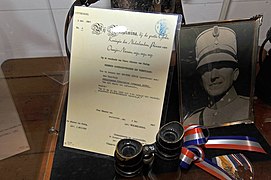Christiaan Boers's Human Design Chart
6/2 Splenic ManifestorDutch captain of the Royal Netherlands Army during World War II.
His parents were Benjamin Hendrik Boers (17 October 1860, Kamerik, Woerden – 6 May 1913, Den Haag), a mathematics teacher and Catharina Petronella Westerburger (1865, Hoorn – 30 April 1947, Amsterdam).
His elder sister Helena Charlotte Wilhelmina Boers (8 February 1887, Den Haag – 7 February 1973, Bergen, NH) married on 2 July 1908 Johannes Franciscus Quanjer (5 August 1877 – 13 Jan 1942, Den Haag).
During the Battle of The Afsluitdijk, he was able to stop the German Blitzkrieg by defending the “kazematten” fortress of Kornwerderzand. The in the thirties built casemates complex defended the Lorentz locks of the Afsluitdijk that regulate the water level of the Ijsselmeer. The locks were a crucial part of the Dutch Waterlinie (water front), in which parts of the Netherlands could be inundated with river water (Rhine, River Ijsel) or if not available with salt Zuiderzee water, to stop attackers.
When engineer Lely built De Afsluitdijk, the Dutch ministry of War demanded strong defences of the crucial sluices. If they were bombed or occupied, the Dutch would loose control about the water level in the Water front and some two thirds of the Netherlands could be flooded. So the Lorentz sluices, named after Hendrik Lorentz, were protected by thick concrete and a system of many small dispersed casemates. The casemates were dispersed to minimize the risk of being destroyed at once by heavy bombs and concentrated artillery fire.
Boers and his 300 soldiers, with help of the Hr.Ms. Johan Maurits van Nassau cannoneer boat from Den Helder, successfully stopped the attacks of the German 1st Cavalry Division of General Kurt Feldt (22 November 1897 – 11 March 1970). Kornwerderzand became the only place in Western Europe where the German blitzkrieg was stopped and where the Germans had to retreat. Only after the medieval city of Rotterdam was bombed on the 14th of May and Utrecht would be bombed next, did the fortifications surrender. The Germans, using some 600 air-planes to defeat the 60 air-planes of the Dutch Royal Air Force, quickly had gained air superiority and used immoral Nazi practices like threatening to bomb open cities to blackmail the Dutch government.
After the Dutch surrender, Boers joined the Dutch resistance. He joined the illegal political organization of former army officers called the OD (Orde Dienst), that was set up to preserve order once the Germans would have been defeated. But the Nazi’s had a different and more “totalitarian” view on Law and Order. They ignored the Trias politica of Montesquieu in “De l’esprit des lois” (The Spirit of the Laws).
Early 1941, his organisation was infiltrated and members became arrested. Boers was prosecuted, arrested and sentenced by the same SD in a puppet show trial in Hotel De Witte called the Proces der 72. The courtroom was filled with swastika flags. Ten lawyers were assigned to 86 men. The suspects got one hour to consult the unprepared lawyers and some last cigarettes. They were groups wise brought to court, where the prosecutors and judges scolded them. They soon realised their faith was in G’ds hand. On 8 April 1942 the court sentenced 72 of the 86 men to death.
He was executed with 63 other of the 72 persons by the Nazi’s at Sachsenhausen concentration camp on 3 May 1942.
Personal
He married Agatha Helena Margaretha Wiepkes (4 April 1897, Velsen – 1979, Amersfoort) in 1918, They divorced in 1928. He remarried Janna van Metz.
Boers was a professional officer, who was considered a natural born leader. It was said that his men would follow him blindly into battle. In the Kazemattenmuseum in Kornwerderzand, run by enthusiastic volunteers, it is still explained why.
Link to Wikipedia
Discover More Famous People
Browse and analyze over 55,000 public figures and celebrities.
Ra Uru Hu
5/1 Manifestor
Martha Stewart
4/6 Manifestor
David Lynch
4/6 Generator
Barack Obama
6/2 Projector
Steve Jobs
6/3 Generator
Vladimir Putin
5/1 Manifestor
Kim Kardashian
3/5 Generator
Michael Jackson
1/3 Projector
Marilyn Monroe
6/2 Projector
Ariana Grande
2/4 Projector
Oprah Winfrey
2/4 Generator
Johnny Depp
2/4 ManifestorWhat is HumanDesign.ai and how does it work?
Curious what makes Christiaan Boers tick? HumanDesign.ai instantly maps their exact birth data into a fully interactive clickable bodygraph chart, letting you hover or tap every center, channel, and gate for plain-language explanations. Bella, the platform’s built-in AI guide, adds context in real time, translating complex mechanics into everyday insights so you can see how Christiaan Boers’s strengths, challenges, and life themes play out on-screen.
The same tools are waiting for you. Generate your own Human Design Chart in seconds, open a library of 2000+ suggested questions, and chat with Bella as often as you like to decode your design, daily transits, and even relationship dynamics.
Want to compare energies? Save unlimited charts for friends, family, or clients, then ask Bella to reveal compatibilities, composite patterns, or coaching tips, all in one conversation thread.
Start free with core features, or unlock our Personal and Pro plans for deeper dives: unlimited Q&A, celebrity chart search spanning 55,000+ public figures, white-label PDF reports, branded content generation, and a professional profile with built-in booking for practitioners. Whether you’re exploring your own potential or guiding others, HumanDesign.ai delivers an ever-expanding toolbox of AI-powered insights—no spreadsheets, no jargon, just clarity at your fingertips.
Ready to see yours? Signup for FREE today!

